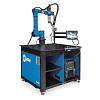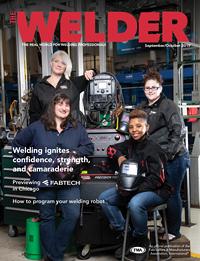Senior Company Trainer
- FMA
- The Fabricator
- FABTECH
- Canadian Metalworking
Categories
- Additive Manufacturing
- Aluminum Welding
- Arc Welding
- Assembly and Joining
- Automation and Robotics
- Bending and Forming
- Consumables
- Cutting and Weld Prep
- Electric Vehicles
- En Español
- Finishing
- Hydroforming
- Laser Cutting
- Laser Welding
- Machining
- Manufacturing Software
- Materials Handling
- Metals/Materials
- Oxyfuel Cutting
- Plasma Cutting
- Power Tools
- Punching and Other Holemaking
- Roll Forming
- Safety
- Sawing
- Shearing
- Shop Management
- Testing and Measuring
- Tube and Pipe Fabrication
- Tube and Pipe Production
- Waterjet Cutting
Industry Directory
Webcasts
Podcasts
FAB 40
Advertise
Subscribe
Account Login
Search
Jim’s Cover Pass: 15 keys to building a successful welding program
Best training practices for welder instructors
- By Jim Mosman, AWS, CWI/CWE
- September 30, 2019
- Article
- Arc Welding
Q: I noticed that you recently retired from your position as a welding instructor after several years. Please share your thoughts on what it takes to be a successful welding instructor.
A: During my 21 years as the lead welding instructor and department chair at a community college, I spent a lot of that time sharing best practices with our fellow instructors around the globe. I believe the following keys can help you build a strong, successful welding training program.
When interacting with students:
1. Know your students and call them by their first name. Engage every student, every class session.
2. Shake your student’s hand every day when they come to your class and let them know you are glad to see them. And again, as they leave, shake their hand and tell them you will see them at the next class.
3. Show students respect. Every person responds positively when they believe you respect their feelings, ideas, and time.
4. Have a personal conversation with each student for a few minutes at least once a week.
5. Instill the importance of soft skills into every class and lesson.
6. Give lessons about the realities of life. Even if all your students don’t end up as welders in the industry, hopefully they will end up as informed, productive members of the greater society. We are in the business of changing lives and building careers. For myself, it is not just a job, it is a career and a calling. Keep training the next generation of welders!
When implementing curriculum:
7. Understand that you can’t teach welding (manufacturing, industrial tech, etc.) today the same way you were taught. It’s your duty to prepare students for their next 10 years, not your last 20.
8. Embrace and use equipment and technology that is up-to-date. Realize that the industry is constantly changing, and technology is a huge reason for that.
9. Instill the ideas of Industry 4.0. Understand that the industry, the equipment, the student, and instructional formats are all connected via the internet.
10. Use the power of social media to connect with potential, current, and past students. Use private pages to stay connected without outside influences.
11. Use textbooks and online resources as reinforcements to the syllabus, not as the sole source of your lessons and curriculum.
On developing partnerships with local industry:
12. Partner with local industry to create a strong and supportive advisory board. Invite members of your local Chamber of Commerce or Economic Development Council to all advisory meetings.
13. Develop internship partnerships with local industry to give your students real-world work experience.
14. Don’t be afraid to ask for help with equipment, supplies, or grant applications. The industry will benefit from professional students who can use the latest equipment.
15. The potential employers of your students are your local industries, which makes them your customers. Providing a student who is well-trained is the best thing you can provide to your customers.
About the Author

Jim Mosman, AWS, CWI/CWE
Lincoln Electric Education Division
About the Publication
Related Companies
subscribe now

The Welder, formerly known as Practical Welding Today, is a showcase of the real people who make the products we use and work with every day. This magazine has served the welding community in North America well for more than 20 years.
start your free subscription- Stay connected from anywhere

Easily access valuable industry resources now with full access to the digital edition of The Fabricator.

Easily access valuable industry resources now with full access to the digital edition of The Welder.

Easily access valuable industry resources now with full access to the digital edition of The Tube and Pipe Journal.
- Podcasting
- Podcast:
- The Fabricator Podcast
- Published:
- 04/30/2024
- Running Time:
- 53:00
Seth Feldman of Iowa-based Wertzbaugher Services joins The Fabricator Podcast to offer his take as a Gen Zer...
- Trending Articles
Aluminum MIG wires offer smooth feeding, reduced tangling

The role of flux in submerged arc welding performance

Three ESAB welding machines win Red Dot Awards for product design

Power source added to cobot welding system for simplified automation

Torch made for welding thin, conductive sheet metal

- Industry Events
Pipe and Tube Conference
- May 21 - 22, 2024
- Omaha, NE
World-Class Roll Forming Workshop
- June 5 - 6, 2024
- Louisville, KY
Advanced Laser Application Workshop
- June 25 - 27, 2024
- Novi, MI
Precision Press Brake Certificate Course
- July 31 - August 1, 2024
- Elgin,




























